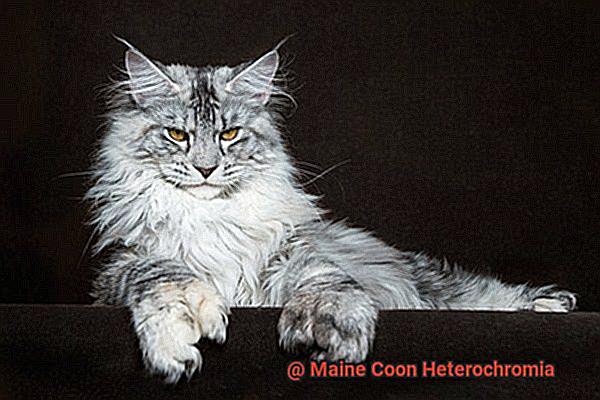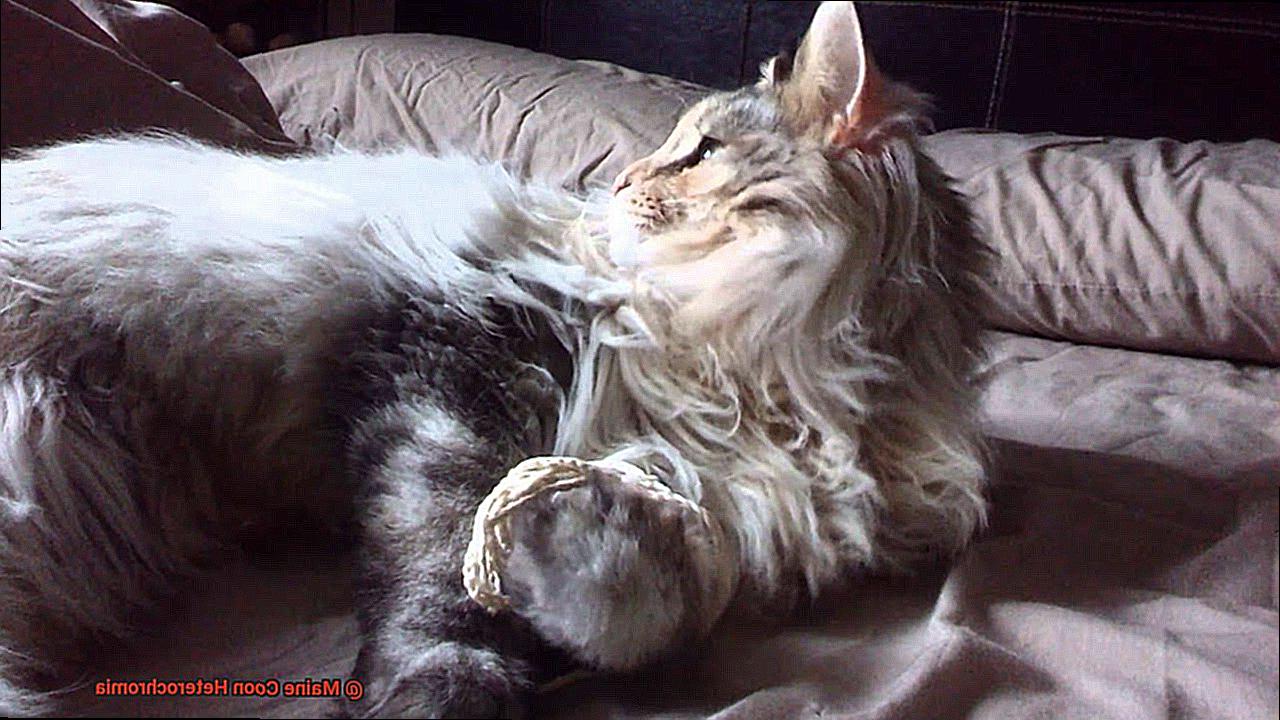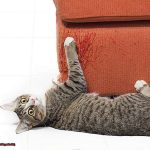Welcome to the fascinating world of Maine Coon cats and their mesmerizing eyes. As a proud cat owner, you may have noticed something extraordinary about your Maine Coon’s eyes – Heterochromia. This rare genetic condition affects thousands of Maine Coons worldwide, making them unique and stunningly beautiful.
Heterochromia is a captivating phenomenon that occurs when a cat’s eyes have different colors due to an irregular distribution of melanin-producing cells in the iris. It can result in one eye being a different color than the other or having two separate colors in one eye, creating a striking visual effect.
Maine Coon Heterochromia is not an illness and doesn’t affect a cat’s vision. Instead, it’s a remarkable and exclusive trait that sets Maine Coons apart from all other feline breeds. Their stunning eyes are like works of art that captivate everyone who sees them.
In this article, we will delve into the captivating universe of Maine Coon Heterochromia, exploring what it is, its different types, causes, and significance in feline culture. We’ll also provide tips on how to care for your Maine Coon with Heterochromia and what to look out for in case of any issues.
Whether you’re an avid fan of Maine Coon cats or simply love cats in general, this article promises to be an exciting and informative read. So sit back, relax and let us take you on a journey through the dynamic world of Maine Coon Heterochromia.
What is Maine Coon Heterochromia?
If you are an owner of a Maine Coon cat, you may have noticed that your fur baby has two different colored eyes. This is known as Maine Coon Heterochromia, a genetic trait that causes one eye to have less melanin than the other, resulting in a blue or green color.

Maine Coon Heterochromia is a fascinating phenomenon that is common in many breeds of cats and dogs. However, it is more prevalent in white or bi-colored cats, making it a distinctive trait of the Maine Coon breed.
Heterochromia can either be complete, where one eye is entirely a different color than the other, or partial, where only part of one eye is a different color. In Maine Coons, partial heterochromia is more common than complete heterochromia.
While heterochromia is typically harmless and purely cosmetic, it can sometimes be an indicator of underlying medical conditions such as deafness or neurological disorders. Therefore, it is crucial to monitor your cat’s overall health and wellbeing regularly.
Despite the potential health concerns, Maine Coon Heterochromia does not affect your cat’s vision or overall health. It is only a natural genetic trait that makes them unique and strikingly beautiful.
It’s worth noting that cats with heterochromia are perfectly healthy and happy pets who simply have a unique and striking appearance. They are still the same loving and playful cat that you know and adore.
In conclusion, Maine Coon Heterochromia is a remarkable genetic trait that results in two different colored eyes, making your cat stand out from the rest. As with any concerns about your cat’s health or wellbeing, it’s always recommended to consult with a veterinarian for proper diagnosis and treatment.
Causes of Maine Coon Heterochromia
Maine Coon Heterochromia is a striking genetic mutation that causes one or both of a cat’s eyes to have different colors. This unique trait is particularly common in Maine Coon cats, but it can also occur in other cat breeds, such as the Turkish Van and the Persian.
So, what exactly causes this enchanting trait? The answer lies in a genetic mutation that affects the distribution of melanin in the iris. Melanin is responsible for giving color to the hair, skin, and eyes. When there is an unequal distribution of melanin in the iris, heterochromia can occur.
While some breeders may selectively breed for heterochromia, it is important to note that this unique trait can also occur naturally in litters without intentionally breeding for it. But regardless of how heterochromia appears, it does not typically affect a cat’s vision or overall health.
It is worth noting that heterochromia can also be caused by injury or disease, such as glaucoma or uveitis. However, in these cases, the condition would likely only affect one eye and could potentially lead to vision problems.
The beauty of Maine Coon Heterochromia lies not only in its striking appearance but also in its fascinating genetic history. This unique trait is passed down from one generation to another through genes and adds a touch of individuality to these already magnificent cats.
Signs and Symptoms of Maine Coon Heterochromia
Maine Coon Heterochromia is a captivating genetic mutation that causes one or both of a Maine Coon’s eyes to have different colors. This condition is more common in Maine Coons than in other breeds, and while it’s easy to spot, there are a few signs to look out for.
The most obvious sign of Maine Coon Heterochromia is the difference in eye color between the two eyes. However, uneven pupil sizes may also indicate the presence of this condition. If one pupil is larger than the other, your cat may have heterochromia. Eye irritation or discharge is another symptom to watch out for, as it can cause discomfort and pain for your furry friend. Additionally, sensitivity to light is a common symptom of this condition. Your cat may squint or avoid bright lights altogether if one eye is more sensitive to light than the other. Lastly, vision problems are another symptom of this condition that can interfere with their ability to navigate their environment and play as they normally would.

It’s essential to note that not all cats with heterochromia will exhibit all of these symptoms, and some may not show any symptoms at all. Therefore, it’s critical to take your Maine Coon cat to a veterinarian for a proper diagnosis if you detect any signs of heterochromia.
Diagnosis of Maine Coon Heterochromia
While it may seem like a mesmerizing and enchanting feature, it’s essential to look out for signs such as uneven pupil sizes, eye irritation or discharge, sensitivity to light, and vision problems.
The good news is that diagnosing Maine Coon heterochromia is usually a straightforward process that involves a physical examination by a veterinarian. During this examination, the vet will carefully examine your cat’s eyes and look for differences in color, shape, and size. They may also perform additional tests like the Schirmer tear test to rule out any underlying health issues that could be causing the heterochromia.
The Schirmer tear test measures the amount of tears your cat produces and helps determine if there are any underlying eye conditions that could be causing the heterochromia. In some cases, the vet may also perform a genetic test to determine if there are any underlying genetic disorders that could be causing the condition.
It’s important to note that not all cases of heterochromia require medical treatment. If your cat is not experiencing any discomfort or vision problems due to their heterochromia, then it may not be necessary to treat it at all. However, if there are underlying health issues or genetic disorders present, then treatment may be necessary.

Treatment of Maine Coon Heterochromia
Maine Coon cats are known for their stunning appearance, and one of the most striking features is their heterochromatic eyes. This condition refers to when a cat has eyes of two different colors, which can be a cause for concern for some owners. While there is no known cure for Maine Coon Heterochromia, there are several treatment options available that can help your cat stay healthy and happy.
One of the most crucial things you can do as an owner is to regularly check your cat’s eyes. Keeping an eye on any changes in size, shape, or color can help detect any abnormalities early on. By taking immediate action and visiting a vet if anything looks irregular, you can ensure that your cat receives the necessary treatment promptly.
Another important aspect of managing Maine Coon Heterochromia is to provide your cat with a healthy and balanced diet. A well-nourished cat is less likely to develop eye-related health problems, and supplements such as Vitamin C and E can help maintain healthy eyes.

In some cases, medication may be prescribed by a veterinarian to manage underlying conditions that may be causing heterochromia. For instance, antibiotics or anti-inflammatory drugs may be prescribed if there is an infection or inflammation present in one eye.
Keeping your cat’s environment clean and free from irritants is also crucial in managing this condition. Regularly cleaning litter boxes and avoiding exposing your cat to cigarette smoke or other pollutants can help your cat’s health overall.
Coping with Maine Coon Heterochromia
Heterochromia causes one eye to be a different color than the other, and in Maine Coons, it typically results in one blue eye and one gold or green eye.
Although heterochromia doesn’t usually cause any health concerns for cats, it can impact their vision. The eye with more melanin tends to have better vision, while the eye with less melanin may be weaker, causing depth perception issues and difficulty judging distances accurately.
Fortunately, there are ways to help your cat cope with this condition and live a happy and healthy life. Observing your cat’s behavior and movements closely is key. If you notice that they’re struggling with depth perception or seem to have trouble navigating their surroundings, consider making some adjustments to their environment. Adding rugs or mats to slippery surfaces can help your cat get better traction when walking or running.
Keeping up with regular veterinary checkups is also crucial. This will ensure that your cat’s vision isn’t deteriorating and that there are no underlying health issues that could be affecting their eyes. Regular checkups can also help identify potential problems early on, allowing for prompt treatment.
A healthy diet is essential for maintaining overall health and wellbeing, including good eye health. Providing your Maine Coon with a balanced diet rich in essential nutrients can help them cope with Heterochromia.
Lastly, maintaining a clean environment free from irritants can go a long way in keeping your cat healthy. Cleaning their litter box regularly and providing fresh water daily can help prevent infections or other eye-related issues.
Conclusion
In summary, Maine Coon Heterochromia is a rare and captivating genetic trait that causes one or both of a cat’s eyes to have different colors. This unique feature sets Maine Coons apart from other feline breeds, making them even more stunningly beautiful. While heterochromia typically doesn’t affect a cat’s vision or overall health, it’s crucial to monitor your furry friend regularly for any signs of discomfort or underlying medical conditions.
To diagnose Maine Coon Heterochromia, a physical examination by a veterinarian is usually sufficient. Treatment options include medication, supplements, and maintaining a clean environment free from irritants. Coping with this condition involves making adjustments to your cat’s environment if necessary, providing them with a balanced diet rich in essential nutrients, and keeping up with regular veterinary checkups.
Maine Coon Heterochromia not only fascinates but also adds an element of individuality to these magnificent cats.

